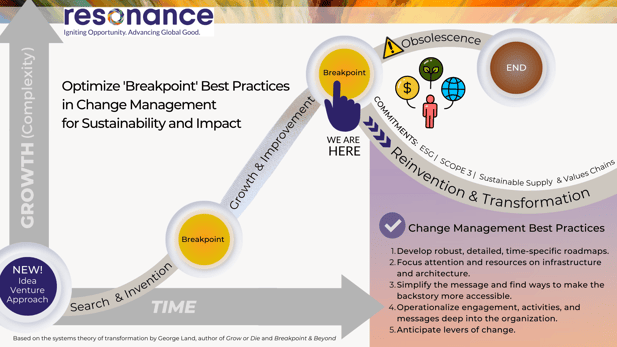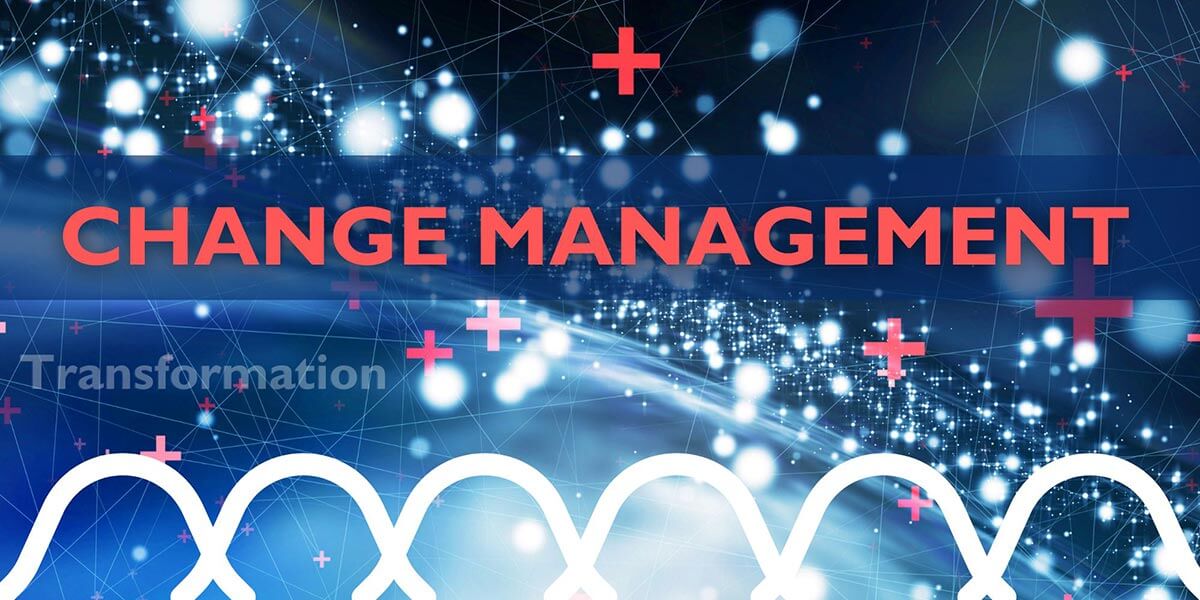Resonance recently convened a gathering of sustainability executives across several industries to explore the challenges they are facing.
Whether it’s Scope 3 emissions reductions, ESG, or commitments to corporate sustainability across supply and values chains, it is obvious we are experiencing what George Land would dub a systemic (even wicked) ‘breakpoint,” in which transformation is necessary, and many intersecting solutions are on the table.
What Are Breakpoints?
Land applied his theoretical research on the three phases of natural systems -- search, growth, and reinvention -- to companies and organizations of all types. He suggested as businesses and sectors move through each phase, there are numerous ‘breakpoints’ where the rules for success change.
How leaders and teams both anticipate and manage change during these phased breakpoints, he noted, can either lead to literal death of an idea, trajectory, or the organization itself, or through adaptation and advancement of innovation, propel the organization forward as part of a transformed system.
5 Best Practices For ‘Breakpoint’ Change Management
We learned in our first of three deep conversations that breakpoints are uncertain and messy, but also marked by a great deal of creativity as companies remain future focused and explore collaborative results. What emerged from this discussion was a slate of best practices that ground specific commitment benchmarks and processes across the company and supply chains.
The following captures some of their valued insights.
1. Develop robust, detailed, time-specific roadmaps.
It is critical for organizations to develop actionable roadmaps to sustainable impact that not only identify and communicate where the company wants to go and when, but also the many possible pathways to get there. These foundational undertakings provide clear direction company-wide and allow stakeholders to adopt, adapt, and advance strategies that support their segment of the journey to goal attainment.
To be successful, sustainability cannot be siloed in a single department or business unit, it must be a truly whole of enterprise approach, leveraging resources, networks, and capabilities across the enterprise to drive lasting sustainable impact.
Clear communication becomes paramount during every facet of this development phase. Ideally, mission-critical objectives and culture should converge to ground customized facilitative tools for teams to collaborate and drive change. And although some companies may have dedicated staff to lead these efforts, external collaboration and partnerships can be valuable in leveraging and complementing existing resources and strengths, or filling capability gaps.
2. Focus attention and resources on infrastructure and architecture.
Most sustainability departments are still relatively new additions to corporate structures. Early on, those at the helm say they were engaged in developing initiatives to promote broadly adopting “sustainability” across the organization and even supply chains through broad awareness and targeted changes.
However, given the urgency of pressing challenges, sustainability leaders are being called to shift gears and embrace new processes that pack real ROI and demonstrate commitment. This includes approaches that aid in asking the right questions in challenge definition, and organization-wide attentiveness to data gathering, tracking, and optimization. Sustainability leaders said ideally approaches should focus on alignment and embed flexibility.
Building out infrastructure and architecture upstream and downstream relies on processes of gated innovation and design that are both foundational at the start and iterative over time. Ongoing organizational monitoring, evaluation and learning (MEL) tools are akin to the components that make the compass work and ultimately guide companies in attaining roadmap objectives often through realignment.
3. Simplify the message and find ways to make the backstory more accessible.
Garnering buy-in from employees, boards, suppliers, and other stakeholders to corporate sustainability commitments is a challenge often accompanied by a trepidation of the unknown, and in some cases even resistance. In addition, the climate and sustainability discussions are laden with technical terms and scientific concepts. How do you plan to make this accessible to stakeholders, especially when messages must traverse global supply chains embedded in unique culture, local knowledge, and institutions?
As brothers and authors Chip and Dan Heath state as part of their SUCCESs model, the first ‘S’ – Simplifying – doesn’t mean dumbing down the message. Instead, “simple” means finding and conveying the core and prioritizing what else absolutely must be included but retooled for ‘stickiness’ (and that includes stripping away the unnecessary).
We do know it takes far more than messaging to shift attitudes, values, and ultimately behaviors. Research shows people need to agree a challenge is demonstrably real and one they care about first. Leaders must be attuned to conveying regularly not only the what of these efforts, but the why (why it matters). This is the roadmap backstory. And that means tying actions to not only values, but the affective (sometimes emotive) effects on those impacted by change.
4. Operationalize engagement, activities, and messages deep into the organization.
One sustainability leader referenced affirmation of his team’s work when an employee spoke in a recent meeting without prompt about the ways their daily work was tied to ESG goals.
This example demonstrates the importance of advancing accessible messaging and the backstory deep within the organization. This requires understanding organizational culture and receptiveness.
According to a recent article published in MIT Sloan’s Management Review, leaders should steer clear of traditional methods of surveying employees as an isolated approach in developing internalization approaches. These tend to overfocus on core shared values, illuminating common tendencies and redundancies, and thus overshadowing powerful new insights.
Mapping patterns of collaboration in an organization provides a sort of
X-ray view of its inner workings, revealing unexpected silos and individuals who may be integral to the change process as opinion leaders and informal network facilitators" - (Gray, Cross & Arena, 2022).
Instead, the authors suggest greater understanding of organizational culture can be gained by mapping patterns of collaboration utilizing network analysis combined with interview data. These approaches and other specialized tools uncover ways to both align strategy to an organization’s roadmap and implement targeted approaches to facilitate transformative change. This including identifying diverse, influential, and sometimes unexpected changemakers in an organization who can serve as influential champions.
5. Anticipate levers of change.
Most organizational challenges are new and compounded by urgency. There should be realistic expectations horizontally and vertically that course corrections will be necessary. Even if unexpected, pivot points should be viewed optimistically as opportunities for both internal and open innovation and when successfully navigated, these levers of change demonstrate organizational dynamism and resiliency.
Facilitative leadership is key to keeping the organization headed in the right direction while motivating teams and stakeholders to develop and refine novel and valued approaches to get there. During pivots, the environment can be highly ambiguous, exploratory, and unpredictable, and may require internal and external resources to analyze the landscape, assess capabilities, and actively solve problems.
Exemplified by trial and error and experimentation to see what connections can be forged, these pivots can be quite volatile, and less nimble organizations might falter. However, through creativity and change management, a connection can happen (a breakpoint), and a new pathway may be illuminated.
How Do Leaders Integrate ‘Breakpoint’ Best Practices for Purpose, Profit, And Impact?
If we apply Land’s Theory of Transformation to this discussion (figure below) we see that intentional reinvention can lead to obsolescence if leaders purposely or inadvertently adopt a pathway isolated from understanding the landscape conditions shaping the organization in this period of global 'breakpoint' change.
 In a different pathway, which requires a revolutionary shift, the integration of new information and inputs, coupled with sound strategy, can propel innovation that is still profitable while impactful. Such efforts require leaders across the system to adopt new behaviors and ideas that may have been rejected along the way during previous periods of non-disrupted growth.
In a different pathway, which requires a revolutionary shift, the integration of new information and inputs, coupled with sound strategy, can propel innovation that is still profitable while impactful. Such efforts require leaders across the system to adopt new behaviors and ideas that may have been rejected along the way during previous periods of non-disrupted growth.
Initiatives will require concerted focus to help teams and stakeholders ideally adapt to and then advance systemic change with robust, detailed, time-specific roadmaps as guidance.




